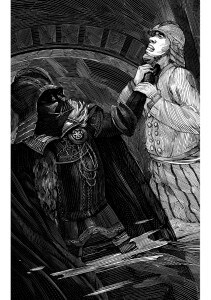Celebrating the release of this summer's William Shakespeare’s The Jedi Doth Return by Ian Doescher, learn the thematic and visual connections between Hamlet, Romeo and Juliet, and a galaxy far, far away.
This summer featured the release of Ian Doescher’s William Shakespeare’s The Jedi Doth Return, the finale of Doescher’s masterful re-working of the Star Wars saga into Shakespearean language. Once again, Doescher merges the storytelling brilliance of George Lucas and William Shakespeare to add another dimension to this saga that has become sacrosanct to so many. This series has brought many fans of Shakespeare to Star Wars and vice-versa, which is a testament to the framework that both of these storytellers exhibit through their respective crafts. Shakespeare used many motifs that are present in the saga, and these criteria all resonate to enhance our enjoyment of Star Wars.
Perhaps the most prevalent motifs found in both Shakespeare and Star Wars is the theme of tragedy. In a Shakespearean tragedy, heroes of prominence in society meet a tragic end, while meeting their fate with grace and dignity, thereby gaining the audience's sympathy. Anakin Skywalker fulfils this category beautifully; as discussed in a previous blog, Anakin is a tragic hero who encapsulates heroism gone wrong, as he turns to the dark side of the Force. Revenge of the Sith provides a canvas for the once promising Jedi to follow a dark path in the name of righteousness, which dooms both him and the galaxy into many years of despair and pain.

Another motif featured in both is the appearance of a ghost that comes to the hero to enlighten them on their quest. Hamlet comes face to face with the ghost of his father’s spirit, who informs him of the journey he must undertake in order to get revenge; this does not end well for the titular tragic hero, but is the catalyst that leads to the climax of the play. Conversely, Luke experiences a similarly transcendent interlocution in the form of his mentor, Obi-Wan Kenobi, who plays the role of father figure to Luke. Both Hamlet and Luke Skywalker receive insights that will forever change the course of their respective destinies. Fortunately for Luke, his Jedi training ultimately leads him to a path separate from Hamlet; both face darkness from fathers, but Luke tempers his passion, while Hamlet is devoured by it.
Young love doomed to tragedy is another theme that is crucial to the drama, as both Romeo and Juliet and Anakin and Padmé face obstacles that seem insurmountable. While both couples have tragic destinies placed before them, it is the choices they make that lead inevitably to unhappy conclusions. Both Shakespeare and Lucas let audiences in on the dramatic irony of each story; the audience knows that both couples will meet a tragic end, but experience the drama with bated breath, hoping for a result that will not come to pass. In both stories, the irony is palpable for audiences.
In Romeo and Juliet, Romeo does not receive the letter from Friar Laurence, which contains essential information that his beloved is not actually dead. The ill-fated letter does not reach its destination due to a plague that quarantines the messenger (Friar John), and prevents him from completing his mission. Romeo assumes the worst, and purchases poison from an Apothecary, sealing his fate. Similarly, the inclination of Anakin to be led by his passion leads to death for both himself and his love. Anakin is not poisoned by an Apothecary, but by his blind loyalty to Palpatine, who wears a robe similar to a friar, but with a dark color that mirrors his twisted soul. Ironically, both Romeo and Anakin believe their initial actions will bring a release from agony, but both characters perpetuate their respective demise, and break not only the hearts on their loved ones, but the audiences as well.

Shakespeare's works utilize motifs that permeate Star Wars, and help enhance our enjoyment of the beloved saga. Through the examples provided above, audiences experience the power of storytelling through these archetypes, and these concepts help to magnify the mythological implications through George Lucas' examination of the Skywalker family. Ian Doescher created a canvas through which readers can discern the similarities between these two masters of storytelling, and discerning the motifs present helps augment the powerful literacy of Lucas' genius.
Dan Zehr is a high school English teacher with an MS in Teaching and Learning, and is a member of the Rogues (as Blue Leader), a network of teachers that incorporate Star Wars in the Classroom. He also runs Coffee With Kenobi (with co-host Cory Clubb), a Star Wars podcast that analyzes the saga through critical thinking, analysis, interviews, and discussion.

